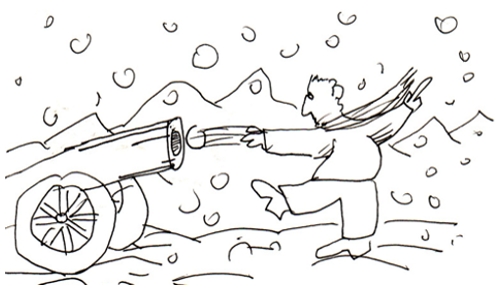Antropologia ed etnica
Antropologia ed etnica
Villa Cappugi, Pistoia
25–26 ottobre 2007
Gli acquerelli sono tratti dai moleskine n. 21 e n. 28, Massimo Presciutti © 2007
Le fotografie sono state scattate nel periodo del Seminario
"Il contributo di eTwinning all'innovazione"
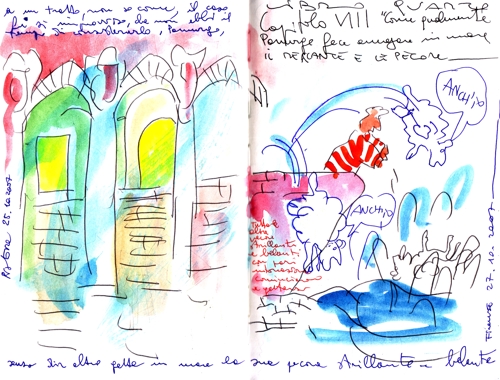
e diventa la prora della nave di Pantagruele
Pistoia in ottobre a tarda sera sembra proteggere il nostro camminare, ho sempre pensato ai mercati di mattina, come quello di Sant'Ambrogio in Santa Croce, lì il fresco frizzante si legge nelle facce vermiglie, mentre in questa città stasera camminiamo tra banchi ovattati di luce artificiale discreta riconoscendo tesori e mondi perduti tra la gramigna del puro presente, paesaggi nascosti alle direttissime, lentezze antiche le cui orme sono isole da leggere e leggende. Il tempo come il mare arriva calmato nella provincia immersa nei suoi tre anelli, "Le mura di Pistoia" filtrano la storia intesa come conquista e la fondono insieme alle fiabe, le luci sulle quinte della Piazza Centrale ci ricordano l'intervento al Convegno di uno dei Professori, il sapere è l'unica cosa che possa essere distribuito senza che sia diviso, penso moltiplicabile come biblici pesci, nella società della conoscenza sarà vincente chi riuscirà a riconoscersi protagonista del processo cognitivo. Vincere o conquistare, questo sarà il problema dell'essere.
Le mura di Pistoia sono state costruite in tempi diversi, come conchiglia fragile contenente una vertebrata forma di vita, contenente a sua volta il suono di memorie apparentemente inconciliabili che si strutturano e vivono grazie all'essere umano. C'è un abisso non so quanto colmabile tra chi mette nomi in gusci vuoti come se avvicinando queste all'orecchio si potessero udire segni di esistenze anteriori a personale uso e supporto, e chi ha pudore nel pronunciarle direttamente dopo averle casualmente trovate, come se così facendo si vendesse l'anima delle cose più care, novelli Faust, in cambio di una gioventù peraltro tutta da provare.
Camminando casualmente una sera di novembre tra i ricordi, credo fosse novembre perché a Firenze di novembre ti senti come dentro un bicchiere di orzata sui lungarni a volte, mi trovo in casa di Piero Bigongiari per chiedere un suo intervento poi pubblicato in una situazione molto simile a quella in cui mi trovavo alla Facoltà di Magistero verso i vent'anni, lo stesso professore mite e sano che dava voti sapendo distinguere l'anima pecorina dal talento al di là delle risposte esatte: "E, tanto per cominciare, si tolgano le orribili catene e transenne e cordoli che sfigurano il volto di Firenze, restituendole il suo volto più autentico, che è un volto severo ma accogliente" (Piero Bigongiari, Politica come servizio e cultura come ispirazione, sta in Realtà sociale, anno III n. 4 – Ottobre–Dicembre 1993 – Periodico Trimestrale – Direttore Responsabile: Vincenzo Enzo D’Angelo).
Dopo Pistoia, dopo che avevo pensato all'anima dei luoghi, e dopo averne parlato in pubblico ai colleghi, mi sono messo a cercare il libro di poesie "Le mura di Pistoia" di Piero Bigongiari, operazione difficile, il volume della serie "I poeti dello Specchio", Arnoldo Mondatori Editore, fu pubblicato nel 1958, coperto di una elegante carta velina, oggetto da antiquariato. Invece lo trovai subito senza averlo cercato il lunedì successivo al fine settimana del Seminario, stavo camminando pensando semplicemente a quanto fosse bello camminare, quando mi trovai alla mia sinistra il volto severo ma accogliente della Biblioteca Marucelliana in via Cavour. Le stesse schede, lo stesso stile, "... la cara consuetudine...". Impossibile trovare nel libro qualcosa sulle mura di Pistoia, le mura sono solo nel titolo, giustamente una volta superate non occorrono più, mentre almeno una risposta in un verso la trovo:
e lascia sulle mani delle vecchie
tessitrici – sulle aie – la matassa
che ci aggroviglia, lascia alle ghiandaie
il grido, il metro: tu non sei un esempio.
Forse ora si può parlare anche di cosa sia l'innovazione ovvero la linfa vitale che permette alle tradizioni di vivere, il presente che contiene il passato, l'essere umano che va oltre un patto sociale tendenzioso diventato muro e catena, quindi un'arte che non propone esempi da seguire e un artigianato che invece è di per sé stesso esempio, un esempio profondo che va oltre la vita della singola persona (ricordo a proposito la difficoltà di Benigni e Troisi nel film "Non ci resta che piangere", i quali, catapultati a cavallo tra il 1400 e il 1500 si rendono conto della impossibilità di ricostruire un oggetto di uso comune e fatto in serie qual'è una lampadina). Da questo punto di vista si potrebbe dire che l'arte non sia altro che artigianato visto alla velocità della luce nello spazio tempo di una singola vita umana.
Si parla di arte perché esiste anche un'arte dell'educare nella misura in cui esiste un'arte dell'apprendere. L'arte è qualcosa che accomuna tutti gli esseri umani. Parlare di etnie è antiscientifico e quindi molto pericoloso, al di là dell'intenzione con cui la parola "etnico" viene pronunciata. Esiste una scienza per studiare l'essere umano visto nello spazio e nel tempo e tale scienza è l'"Antropologia" (se non va bene com'è inventiamola: niente vieta una volta tanto che invece di cambiare nome si possa cambiare contenuto).
Qui si parla quindi della bellezza dei singoli artisti la cui luce ha dato l'anima ai luoghi (Lucca è Puccini, Pesaro è Rossini) o addirittura a intere nazioni (Spagna è Cervantes, Francia è Rabelais, Inghilterra è Shakespeare), della grandezza dei popoli che hanno vissuto collettivamente una singola anima che affonda le proprie radici nelle più antiche leggende e fiabe e che diventa "immortale" proprio grazie al riconoscimento delle nuove luci che brillanti si succedono nel corso del tempo.
Queste le basi (definite ora meglio scrivendo il presente articolo) del gruppo di lavoro a Pistoia durante il seminario, persone diverse insieme per creare un progetto.
La memoria immortale e l'effimero della vita singola vengono individuati nel tema della Piazza, le piazze d'Europa come luogo di incontro e di crocevia nel presente in uno spazio progettato da uno o più singoli esseri umani che racchiude e ripropone modelli del passato.
Invenzioni di piazze utopiche con solide radici e non di castelli in aria quindi, sulla linea di Giorgio De Chirico, per esempio, ma non seguendo il suo esempio perché i progetti innovativi non possono avere esempi.
Le sorgenti di tali invenzioni dovranno scaturire invece da inedite connessioni trovate vivendo l'avventura del viaggio nello spazio tempo.
Nella nostra classe soltanto in pochi giorni abbiamo scoperto interessanti spazi e tempi leggendo e quindi raccontando oralmente i capitoli IX e X del Quarto Libro di "Gargantua e Pantagruel" di François Rabelais. Con la parola "scoperta" si intende un metodo di studio e di insegnamento applicabile a una classe Quarta Elementare. Siamo nella Francia del 1547 quando esce il Quarto libro. Noi siamo in una classe della Firenze del 5 novembre 2007. Epistemone, uno dei compagni di Pantagruele, parla di Firenze, con cognizione di causa in quanto per la stesura di questo episodio François Rabelais fa uso dei ricordi personali raccolti in un viaggio fatto per l'appunto a Firenze nel 1536. La vicinanza della Francia con Firenze era certamente dovuta al fatto che la regina di Francia era in quel tempo Caterina de' Medici sposa di Enrico II. La stessa Caterina che di fronte a un nuovo dolce che le viene proposto dai cuochi reali esclama: "Sembrano le bugne di Palazzo Pitti" (da qui il nome bignè per indicare quello stesso dolce). "Quando furono ben vicini, videro che la casina era fatta di pane e coperta di focaccia; ma le finestre erano di zucchero trasparente" (Jacob e Wilhelm Grimm, Fiabe, Einaudi, Torino 1951).
E a proposito di Utopie François Rabelais non fa che inventarne, a cominciare da quella più famosa, L'Abbazia di Thélème, capitoli LII-LVII, Libro Primo (la cui unica regola è "fai ciò che vuoi"), descritta talmente bene che Gustave Doré la può disegnare puntualmente. Anche il viaggio cui assistiamo in questo inizio novembre in classe è un viaggio utopico, direzione Oceano Atlantico, l'America ancora avvolta nel mistero. Arrivano nell'isola di Ennasin: "La chiamavano l'isola delle Parentele. Uomini e donne vi somigliano a quelli rossi del Poitou, eccetto che hanno, uomini donne e bambini, il naso formato come l'asso di fiori". Che buffi nasi! Molto somiglianti al naso di un vecchio ritratto in un quadro del 1488, ora al Louvre, ma dipinto a Firenze.
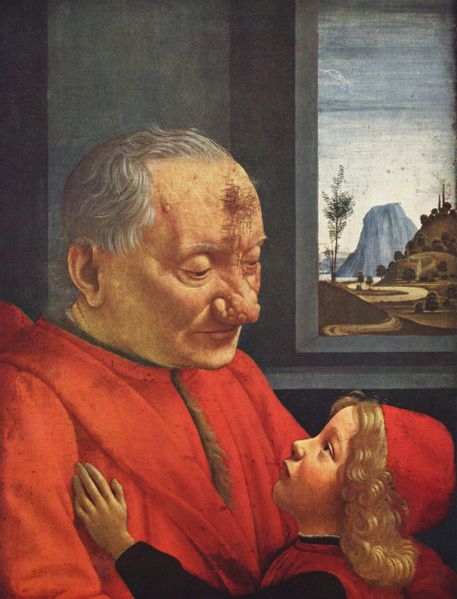
"Ritratto di vecchio con fanciullo", Parigi, Louvre
La lettura del quadro sembra descrivere proprio uno degli abitanti dell'isola di Ennasin: "Il vecchio, certamente un nonno, col suo grosso naso bitorzoluto, un naso con tanti 'nasini', ha l'acuta espressione di un fiorentino anziano, tutto sagacia e saggezza" (Emma Micheletti, Domenico Ghirlandaio, Firenze 1990).
"Incontriamoci in Piazza Europa" è il titolo individuato dagli insegnanti del gruppo (uso il maschile una volta tanto anche per le donne), provenienti da diverse scuole del Centro Italia e delle Isole, sotto l'impulso dello staff nazionale eTwinning. Disegni di una piazza utopica attraverso viaggi nello spazio tempo con un metodo coerente, che abbiano alla base appunti di percorsi di letture e di aneddoti, ma anche di disegni dal vero o meglio "schizzi" veloci e impressioni. Le tracce rimaste sul quaderno (magari elaborate sulla base del primo appunto con colori e aggiunte scritte) e le opere grafiche delle piazze utopiche saranno i prodotti finali di un Progetto che, in linea con la scuola europea, sarà ancora l'incontro reale di attività e memoria, come preludio necessario alla conoscenza.
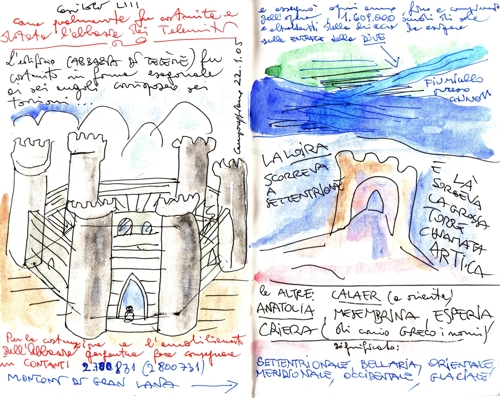
Anthropology and ethnic matter
Villa Cappugi, Pistoia
October 25–26, 2007
Water colours from moleskine n. 21 and n. 28, Massimo Presciutti © 2007
"The contribution to innovation by eTwinning"
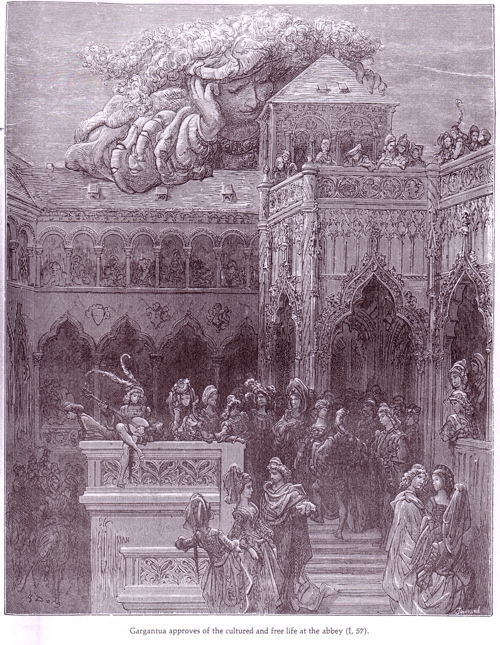
Illustration for "Gargantua and Pantagruel" by François Rabelais
Pistoia in October, during the late evenings, seems to preserve our walking. I was always thinking of the markets in the morning, like the one in Sant'Ambrogio in Santa Croce district, where the chilling weather is perceptible on the vermilion faces, meanwhile in this town late this evening we are walking among stands muffled by delicate artificial light, recognizing treasures and lost world among the dog's tooth of the pure present, hidden landscapes to the motorways, old slowness whose prints are islands to read in the same way as legends. The time like the sea comes calmed to this province enclosed by its three rings: "The Pistoia walls" filter the history taken like a conquest and mix that with the folktales, the lights on the wings of the Central Square remind us the speech in the Seminar by one of the Professors, the knowledge is the only thing that we can distribute without being divide, I think it can also be distribute making it increase like in the biblical chapter of multiplication of fish, in this society of knowledge it will be winner who achieves to identify himself like a protagonist of the cognitive process. To beat or to conquer, this will be the problem of being.
The Pistoia walls were built in different times, like a fragile shell that contains a vertebrate life form, and at the same time, the sound of the memories that seems incompatible in its structure itself and alive thanks to human being. There is a void that I don't know how to fill between who puts a names in the empty shells, like if drawing onto these ones to the ear that should hear the signs of the previous existences for his personal use and support, and who has the modesty of pronouncing them directly after finding them by chance. It seems that acting like that it's like selling the soul of the most beloved things, like a new Faust, in exchange for a youth however completely to demonstrate.
Walking by chance a night in November among the memories, I suppose was November because at Florence in November you feel like inside a glass of barley water on the lungarni sometime, I'm in the house of Piero Bigongiari to ask for his contribution later published in a very similar situation to that's where I was to the Magistero school about my twenty, the same gentle and sound professor casting the votes knowing to discriminate sheep soul from the talent beyond the right answers: "And, for a start, it removes the horrible chains and hurdles scarring the image of Florence, it giving it's the more authentic image, that is a severe but welcoming image" (my translation from Piero Bigongiari, Politica come servizio e cultura come ispirazione, sta in Realtà sociale, anno III n. 4 – Ottobre–Dicembre 1993 – Periodico Trimestrale – Direttore Responsabile: Vincenzo Enzo D'Angelo).
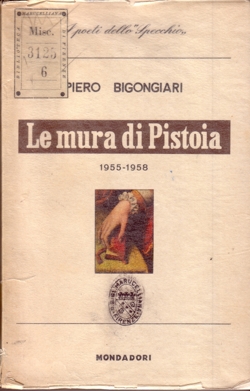
After Pistoia, after I had reflected on the soul of the sights, and after having spoken in public about to my colleagues, I started to look for the book of verse "Le mura di Pistoia" by Piero Bigongiari, difficult operation, the volume of the series "I poeti dello Specchio", Arnoldo Mondadori Editore, was published in 1958, covered with elegant flimsy paper, a fine antique. Whereas I found it soon, without having to look for it from the following Monday to the week – end of the seminar, I was walking on thinking simply to the beautiful walk, when I found on my left the severe but welcoming image of the Biblioteca Marucelliana on via Cavour. The same index cards, the same style, "... the dear usage...". But impossible to find in the book anything about the Pistoia walls, the walls are only in the title, just once overreached they are not more necessaries, at least I found out an answer in a verse:
and you let go in the hands of old woman
weavers – on the farmyard – the skein
tangling us, you let go to the jays
the cry, the poetry: you aren't a model
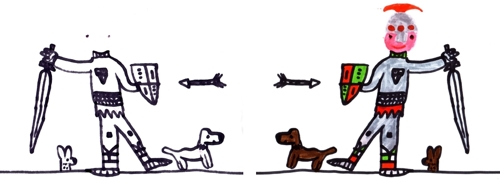
Drawing by Luca Stefanon, IV class of Vittorio Veneto primary school
On the right it's visible the drawing of the pupil, on the left the back of the same drawing, like an other drawing invisible obtained by chance because the sign of the black felt-tip pen went through the paper
Perhaps now we can talk about the innovation that is the lifeblood traditions allowing to live, the present embracing the past, the human beings going over a tendentious social contract turn wall and chain, so an art not suggesting examples to follow and a craft being, on the contrary, a real and proper example in itself, a deep exemple going over the single person's life (I remember by the way the difficulties of Troisi and Benigni in the film "Non ci resta che piangere" ("Nothing left to do but cry", 1984), who, catapulted between 1400 and 1500 realize the impossibility of rebuild an object of common use and serial made like it is a light–bulb). In this perspective we could say that the art isn't other than a craft perceived at the speed of light in the space time of a single human existence.
We are talking about art because if it exists a training art in the same way it exists a learning art. The art is something that unites all the human beings. To talk about the ethnic groups is no scientific and so very dangerous, here after the intentions with which the word "ethnic" was meant. There exists a science to study the human being said in the time and space and this science is the "Anthropology" (if no good such as it is, we can invent: nothing forbidden for once that instead of changing the name we could change the substance.
So here we are talking about the beauty of the single artist whose light gave the soul to the sights (Lucca is Puccini, Pesaro is Rossini) or even to the entire countries (Spain is Cervantes, France is Rabelais, England is Shakespeare), about the greatness of the people communally living a single soul plunging their roots into the oldest legends and fables and becoming "immortal" just thanks to the recognition of the new bright lights coming one after the other in the passing of time.
These are the basis (now defined better on writing the present contribution) of the working group in Pistoia during the seminar, different people all together to create a project.
The immortal memory and the ephemeral of the single life was recognized on the topic of the Square, the Europe squares like a rendezvous and intersection of the present time on a space projected by one or more single human being containing and proposing again a models of the past.
So inventions of utopian squares with stable roots and not of castles in the air, on line with Giorgio De Chirico, for example, but not following his example because innovative projects can't have examples.
The fountains of such inventions will have whereas to such from original connections found living the adventure of the trip through space and time.
In our class in only few days we found interesting spaces and times for reading and then telling about the chapters IX and X of the Fourth Book of "Gargantua and Pantagruel" by François Rabelais. With the word "discovery" we mean a method of studying and teaching applicable to a fourth class of a Primary School. We are in French in 1547 when the Fourth Book was published. We are now in a class in Florence November 5th, 2007. Epistemone, one among the friends of Pantagruel, talks about Florence, knowing what he says because by the writing about of this episode François Rabelais uses of personal memories gathered in a travel in Florence in 1536. The proximity of France with Florence was for sure due to virtue of the queen of France at the time Caterina de' Medici wife of Henry II. The same Caterina that in front of a new sweet proposing to her by the royal cooks exclaims: "It seems the bugne (English: ashlars) of Palazzo Pitti" (from here the name bigné that signifies the same sweet). "When they were very close, they saw that the little house was bread made and flat cake covered; but the transparent sugar for the windows" (my translation from Jacob e Wilhelm Grimm, Fiabe, Einaudi, Torino 1951).
And regarding the Utopias François Rabelais invented a lot, from that one more well-know, the Télème abbacy, chapters LII-LVII, First Book (whose only rule is "make what you want"), described so nice that Gustave Doré can draw it accurately. Even the journey we attend in this early in November in the class it's an utopian journey, Atlantic Ocean direction, the America still wrapped in mystery. They arrive to the Ennasin island: "They called that the Relatives island. Men and women here look alike those red hairs of Poitou, unless having, men and women and children, the nose formed like the ace of flowers". What funny noses! Very similar to the nose of an old man represented on a painting of 1488, now at Louvre, but painted in Florence.
The reading of the painting it looks describe just one of the inhabitants of the Ennasin island: "The old man, in all probability a granddad, with his big knobbly noose, a noose with a lot of 'little nooses', he got the sharp expression of an elderly Florentine, totally sagacity and wisdom" (my translation from Emma Micheletti, Domenico Ghirlandaio, Firenze 1990).
"Let's meet in Europe square" it's a title picked out by the teachers of the group, coming from different schools of Centre of Italy and Islands, under the impulse of the National Staff eTwinning. Drawings about an utopian square by means traveling in the space time with a coherent method, having at heart notes of ways of readings and anecdotes, but also drawing from life or better said, by means "sketch" and impressions. The signs shown on the notebook (even elaborated according to the first notes with colours and written supplements), and the graphic works of the utopian squares will be the final products of a Project that, according with the European School, will be, in fact, the real meeting of activities and memory, like necessary prelude to the knowledge.
